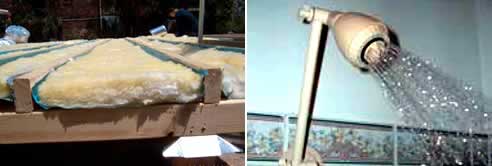NEWS ARTICLE ARCHIVES
Architects - Sustainability specifications from Electronic Blueprint for Australian building products

The Need for a Comprehensive Building Products Sustainability Standard
When considering and rating the sustainability of building products, it is necessary to consider both:
- The sustainability impacts of the manufacture, transport, construction, demolition and re-use of the product; and
- Its effect on the sustainability of the building into which it is built. This consideration must be made
in the context of what is both common practice and what is permissible under the Building Code of Australia.
With a view to ensuring consistency of sustainability assessments and reporting for Australian building
products, Electronic Blueprint has developed a draft Standard, and is currently proceeding with the
necessary steps to encourage its national adoption.
Types of Contributions to Sustainability
The draft Standard must cater for three types of building products, whose sustainability contribution is;
- Direct and Obvious.
- Direct, but Not Obvious.
- Indirect.
Direct and Obvious For example:
- Thermal insulation batts, blanket and foil,
- water tanks,
- water saving shower heads,
- special paints and coatings with very low VOC's.
Direct, but Not Obvious For example:
- Lightweight cladding material might have enhanced thermal insulation, while dense cladding material might
have enhanced thermal mass. Depending on the building use, location and design, either one or the other could
provide a net advantage.
- Roof gutter systems, designed principally to convey water to the storm water system, may also provide some
degree of permanent water storage, or water detention.
- Paints and coatings for normal applications, but with lower than normal VOC's.
Indirect For example:
- Some products fulfil their intended primary function particularly efficiently, thus requiring less of the
material to be used in the finished building.
- Other products are manufactured by processes that consume only low quantities of energy.
- Other products may be recyclable.
Commentary
Set out below is a commentary on the draft Standard.
Scope
The Scope of the draft Standard defines it relevance to sustainability specifications, performance criteria and
the compliance methods for Australian building products, in addition to the Building Code of Australia and ISO 14024.
Principle
The Principle describes the draft Standard’s relevance to greenhouse gas generation, non-renewable resources and l
and, water and air pollution or degradation.
Definitions
The Definitions include some terms consistent with ISO 14024 and the Building Code of Australia, as well as some
developed specifically for sustainability analysis of Australian building products.
Sustainability Criteria
The draft Standard clearly states three broad Sustainability Criteria:
- Demonstration of Fitness for Purpose.
- Compliance with Statutory Requirements.
- Adherence to Sustainability Criteria, including the sustainability of the product in respect of its life cycle; and
the contribution of the product to the overall sustainability of the building during the building life cycle. Considerations
include:
a. Reduction green-house gas generation.
b. Reduction in the use of non-renewable.
c. Reduction in land, water or air pollution or degradation.
Demonstrating Compliance
The draft Standard provides two methods of demonstrating compliance:
- Verification by Calculation and Analysis, viz. considerations of product life–cycle and its contribution to building
sustainability.
- Deemed-to-Satisfy Provisions, whereby compliance with specified forms of construction (in many cases based on the
Building Code of Australia and the Standards referred to therein) is considered suitable.
Sustainability Specifications
The draft Standard describes the use of Sustainability Specifications.
Ecolabelling
The draft Standard clearly links the ecolabelling process to ISO 14024. Reference Documents Appendix A of the Standard
lists the reference documents, including those used to define "Benchmark Construction", against which performance may be
measured.
Benchmark Construction
Appendix B of the Standard describes Benchmark Construction, "the form of building construction that is the most economic
common solution permitted within the mandatory requirements of the Building Code of Australia and relevant Standards referred
to therein". This is the form of construction against which the sustainability performance of particular products can be
assessed and reported.
- The most common types of building envelope are described for various applications.
- The means of determining the benchmark form of construction for each component in a building is described in terms of the
standards and/or regulations governing its design. A distinction is drawn between the standards and regulations governing
"residential" construction and those governing "other" construction.
Verification of Sustainability Criteria by Calculation and Analysis
Appendix C of the Standard describes the method for Verification of Sustainability Criteria by Calculation and Analysis for
each of:
- Reduction green-house gas generation.
- Reduction in the use of non-renewable resources (energy, water and soil).
- Reduction in land, water or air pollution or degradation.
Contribution to Compliance based on Deemed-to-Satisfy Provisions
Appendix D sets out the properties of some building components whose contribution to compliance can be based on Deemed-to-Satisfy
Provisions of the regulations, standards, industry documents or other simple criterion.
Electronic Blueprint is seeking constructive comment and feedback on the proposed methodology specified in the draft Standard.
Please access the complete draft at:
http://electronicblueprint.com.au/updates/
D07090901-1_Sustainability%20Standard.pdf
|
|


